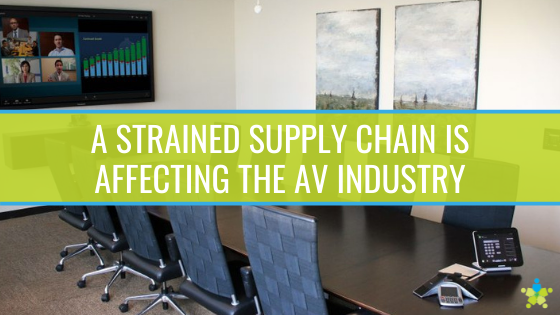[vc_row][vc_column][vc_column_text]Supply chains into the U.S. have been thrown into chaos, and the AV industry is starting to feel the effects. AV integrators, in response, are having to adapt quickly to ensure projects can be completed within a reasonable timeframe and cost. For schools, businesses, and other organizations, it’s never been more important to work with an integrator that is certified and experienced, given the challenges pushed on the AV industry.[/vc_column_text][/vc_column][/vc_row][vc_row][vc_column][vc_column_text]
How is the AV Supply Chain Being Disrupted?
The AV industry is far from the only one dealing with supply chain woes. Manufacturers in nearly every sector are experiencing the same supply chain-related issues, and there’s no simple solution on the horizon. How did the nation’s sprawling logistical pipelines get so tangled? There are a few reasons. Since the beginning of the coronavirus pandemic in early 2020, state and local governments have taken a widely variable approach in producing new regulations in response to the virus. Some of those regulations have made it difficult, if not impossible, to maintain critical links in the supply chain, for a few reasons. For example:- Ports of entry and cargo operations are running slower - Every year, millions of cargo containers are unloaded at U.S. ports of entry, carried overseas from other countries. With so many ships to take in and unload safely, it’s essential that ports of entry function without interruption. Some ports, though, have been required to slow or halt their operations for safety reasons. As the crisis has dragged on, many ports have had no choice but to downsize in light of the pandemic, reducing operating capacity further. Another issue is that there aren’t enough longshoremen to maintain what operating capacity ports have. As a result, hundreds of thousands of container ships are stuck in a massive traffic jam outside major U.S. ports of entry. Many of these ships are carrying components and goods relevant to AV and other technology-focused industries.
- Manufacturing facilities are also running slower - Logistical shocks have also been felt among manufacturing companies, and electronics manufacturing is one of the hardest hit. The pattern is the same - manufacturing facilities have shut down, either temporarily or permanently due to downsizing, and the labor needed to run the facilities has been hard to come by. Not only is it difficult to get needed components and goods into the country, but it’s increasingly difficult to manufacture them as well.
- Demand for certain goods has skyrocketed - People are spending more time at home, either due to pandemic-related restrictions or because they are working remotely. The need for additional technology, such as economical computing devices, has risen accordingly. As such, consumer demand is way up for electronics, among other things. E-commerce is also expanding at incredible rates, as many brick and mortar shops were shut down for weeks or months. Estimates vary, but double-digit growth across the entire e-commerce industry is expected in 2021. That’s a lot of additional pressure put on manufacturers and their ability to maintain inventory, so it’s as if the supply chain is being pulled from both ends.
- Some industries receive priority for critical components - Electronic components are needed by many tech-aligned industries, and because some of those industries are powerful, major component buyers, they are more likely to receive priority when components are available. This is of relevance to AV, as several types of components, semiconductors most notably, have become scarce. Semiconductors are used in the production of display drivers (the device that tells a display what to show) and are essential in many AV projects. However, semiconductors are also used in the commercial TV industry, which is a major buyer of electronic components. It’s possible that manufacturers will prioritize their biggest buyers first, adding to the challenge facing AV integrators.
What can AV integrators do to mitigate supply chain pain?
It’s not clear when supply chain pressures will ease up, but in the interim, schools and businesses can maximize their AV ROI by working with a certified, experienced integrator. Here’s why:- Experienced AV integrators know how to communicate - It’s impossible to forecast when and how the supply chain will return to normal, but a certified integrator will keep their clients informed about what to expect regarding project timelines and product availability. It may not always be possible to expedite parts of the integration process, but a reputable integrator will be honest and realistic throughout. By communicating early and often, a certified integrator ensures their clients can make informed decisions about how to push their project forward.
- They also know how to optimize an AV budget - Even when supply chains are operating smoothly, certified integrators do what they can to get the most out of every AV dollar. That’s even more important, now, as costs are likely going to be passed downstream to the end user, in response to increasing component prices. A certified integrator can make adjustments to account for increasing costs, such as replacing technologies with less expensive alternatives, opting for previously owned equipment instead of brand new, and scaling down solutions where necessary.
- They know how to manage complex project logistics - With experience, AV integrators are able to establish their own in-house logistical chains. When the economy is running normally, this internal organization ensures clients get their projects done on time and on budget. When there are larger disruptions in the supply chain, an experienced integrator’s superior investment in logistics means they will locate and secure needed components before less experienced integrators can.
- Certified integrators can maximize system performance and lifespan - One way to optimize an AV solution is to maintain it for extended performance and stability. Certified integrators know that installation is only the beginning and can provide their clients with a cost-effective maintenance agreement. With an agreement on hand, schools and businesses have a true technology partner in their integrator, one who can provide technical support, maintenance and training for any covered solution.



